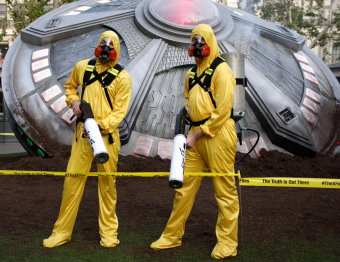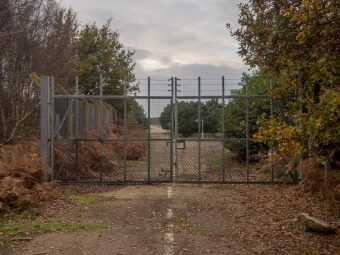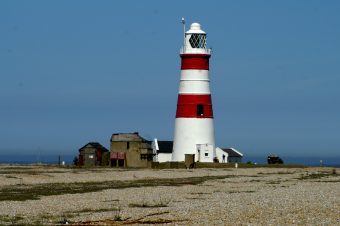England’s Roswell
 Most Americans are familiar with the legend of the UFO landing near Roswell, New Mexico in 1947. But what about the “Incident at Rendlesham” that took place near Ipswich, England, the day after Christmas in 1980? It’s been cited by UFO buffs as one of the most credible sightings of the 20th century.
Most Americans are familiar with the legend of the UFO landing near Roswell, New Mexico in 1947. But what about the “Incident at Rendlesham” that took place near Ipswich, England, the day after Christmas in 1980? It’s been cited by UFO buffs as one of the most credible sightings of the 20th century.
NOT-SO-SILENT NIGHT
Just before 3:00 a.m. on the morning of December 26, 1980, a bright light was seen racing across the night sky over Rendlesham Forest, which separates two Royal Air Force bases: RAF Bentwaters to the north, and RAF Woodbridge, which juts out of the forest’s western edge. The strange light made no noise, but the sight was so startling that the airmen who saw the light thought that an aircraft might have crashed in the forest. They asked for permission to investigate.
Three U.S. Air Force airmen who were patrolling Woodbridge —Staff-Sergeant Jim Penniston, Airman Edward Cabansag, and Airman First Class John Burroughs—were dispatched into the forest to take a look. Nearly 30 years later, they still can’t agree on what they saw among the trees—except for one thing: They all saw a lot of lights. Big lights. Little lights. Colored lights. “Blue, red, white, and yellow,” Cabansag wrote in a report several days later.
(SOMEWHAT) CLOSE ENCOUNTER
In his report, Penniston stated that he thought they had come within 50 yards of the source of the flashing lights. “It was definitely mechanical in nature. This is the closest point that I was near the object at any point. We then proceeded after it.” They moved closer to where they thought the object was, but they never seemed to get any closer to it—it appeared to move farther away as they approached. “It moved in a zig-zagging manner back through the wood and then [we] lost sight of it,” he wrote.
Even creepier than the unexplained lights were the noises. “Strange noises,” Burroughs wrote in his statement, “like a woman screaming. Also the woods lit up and you could hear the farm animals making a lot of noises, and there was a lot of movement in the woods.”
The airmen were in the forest for about an hour before it became clear that whatever they were seeing and hearing, it wasn’t the result of an airplane crash. They were ordered back to base.
At 4:11 a.m., an airman named Chris Armold called the local police, the Suffolk Constabulary, and asked if they’d received any reports of a downed aircraft. They hadn’t, but they sent two officers out to examine the scene anyway. The officers saw nothing unusual. A short time later, Armold accompanied Burroughs on a second trip into the forest. “We could see lights in the distance, and it appeared unusual as it was a sweeping light,” Armold recalled in a 1997 interview. “We also saw some strange colored lights in the distance but were unable to see what they were.”
MAKING AN IMPRESSION
Then after daybreak, more airmen went into the same part of the forest. They found three small indentations in the ground, each one roughly 1½” deep and 7” in diameter, laid out on the ground in a triangular pattern. Were they made by the landing gear of a UFO? The airmen also noticed some strange marks in the surrounding trees: The bark had been removed and the sap had crystallized in the wound. Were they burn or scrape marks made when the UFO lifted off?
A second call to the Suffolk Constabulary brought another officer to the scene…but he didn’t note anything particularly unusual about the marks on the ground or in the trees.
DÉJÀ VIEW
 That might have been the end of the “Incident at Rendlesham” were it not for the fact that on the following night (December 27), airmen on guard duty at the back gate of RAF Woodbridge, which faced Rendlesham Forest, again saw strange lights coming from the forest. When word of the sighting reached the deputy base commander, Lieutenant Colonel Charles Halt, he organized another team of airmen and sometime after midnight led them into the forest to investigate. This time the party brought a Geiger counter and a tape recorder, into which Halt recorded nearly 18 minutes of live observations as the group examined the site over the next four hours.
That might have been the end of the “Incident at Rendlesham” were it not for the fact that on the following night (December 27), airmen on guard duty at the back gate of RAF Woodbridge, which faced Rendlesham Forest, again saw strange lights coming from the forest. When word of the sighting reached the deputy base commander, Lieutenant Colonel Charles Halt, he organized another team of airmen and sometime after midnight led them into the forest to investigate. This time the party brought a Geiger counter and a tape recorder, into which Halt recorded nearly 18 minutes of live observations as the group examined the site over the next four hours.
Halt’s tape recording makes for compelling listening: He and the search team examined the impressions in the ground and the marks on the trees, carefully taking radiation readings as they went. The strongest reading was from one of the indentations, which gave a reading of 0.07 millirems per hour. The men also noticed small branches that had been freshly broken off nearby trees about 15’ to 20’ off the ground, and reported hearing strange animal noises just like the first team had the night before.
WITH THEIR OWN EYES
Then, around 13 minutes into the 18-minute tape, Halt and the men suddenly saw a strange, flashing yellowish-red light in the forest. “It’s coming this way. It’s definitely coming this way! Pieces of it are shooting off,” Halt says into the tape recorder. “There is no doubt about it. This is weird!”
Halt and his team followed the strange light out of the forest, through a field, and past a farmer’s house into another field. “Now we have multiple sightings of up to five lights with a similar shape and all,” he says on the tape, “but they seem to be steady now rather than a pulsating or glow with a red flash.”
They crossed a creek as they pursued the lights, which were now considerably farther away. “Made sighting again about 110°,” Halt says. “This looks like it’s clear off to the coast. It’s right on the horizon. Moves about a bit, and flashes from time to time. Still steady or red in color.” The men saw strobe-light flashes, and then two “strange objects…with colored lights on ’em” to the north, and a similar object to the south, about 10 degrees off the horizon. “Hey, here he comes from the south, he’s coming toward us now,” Halt says. “Now we’re observing what appears to be a beam coming down to the ground. This is unreal!”
Halt and his men watched the strange lights for another 15 minutes, until 3:30 a.m., then headed back to base. At 4:00 a.m., Halt ends the tape by reporting, “One object still hovering over Woodbridge base at about 5 to 10 degrees off the horizon, still moving erratic and similar lights and beaming down as earlier.”
ON PAPER
In the days that followed, Halt had several of the witnesses to the events of December 26 submit written statements describing what they saw and experienced. He used these statements, along with his own recollections from the night of December 27, to write a one-page official memo titled “Unexplained Lights.” In it he describes the object that some witnesses claimed to have seen as “a strange glowing object…metallic in appearance and triangular in shape, approximately two to three meters across the base and approximately two meters high.”
EXTRAORDINARY
Two separate sightings in the same place two days apart, each witnessed by numerous credible witnesses. Written statements describing what was seen, backed by police logs that confirm the dates and times. An official Air Force memo written by the deputy commander of the military base where the events took place. Physical evidence, in the form of indentations in the ground and marks on nearby trees. An actual tape recording of the second encounter as it unfolds. That’s a lot of evidence. Rarely—if ever—has a reported UFO encounter been documented as thoroughly as the Incident at Rendlesham.
NOT SO FAST
For the witnesses of the strange goings-on in Rendlesham Forest, convincing themselves that they’d seen a UFO was one thing—convincing the locals was another. When the story finally broke in the pages of the News of the World, a British tabloid newspaper, in October 1983, the farmers and foresters who lived around Rendlesham Forest didn’t believe a word of it. They hadn’t seen or heard anything unusual on the nights in question, and when a reporter from the Times of London visited the area the day the News of the World story broke, he had no trouble finding locals who were already laughing off some of the key elements of the story.
DUMB YANKEES
Had the American airmen ever even been in a forest before?
- Depressions in the ground of the kind described by the witnesses at the “landing site” are scattered all over the forest—not always arranged by chance into triangular patterns, but they are everywhere. Rabbits dig them, to get at roots under the ground.
- The strange marks in the trees? They were everywhere, too, not just at the landing sight. They weren’t burns or scrapes made by a UFO blasting off—they were axe marks made by foresters to mark the trees that are ready to be cut down.
- The screaming animals? Those were muntjac, also called “barking deer,” who live in Rendlesham Forest and are well known—at least to the locals—for squeaking, barking, and even screaming like human beings when startled by things like, say, bands of agitated airmen roaming through the forest at 3:00 a.m. waving flashlights and talking loudly into tape recorders as they troll for space aliens.
LARGER THAN (EXTRATERRESTRIAL) LIFE
By now the story was taking on a life of its own, helped along by the fact that the original witness statements, though unclassified, still hadn’t been made public. They were gathering dust in an Air Force filing cabinet somewhere. Only the Halt memo had been leaked to the News of the World.
Without their original written statements to pin them down, some of the witnesses apparently began to embellish their stories. Remember how Jim Penniston reported that the closest he ever came to the object was 50 yards, or half a football field, away? In time he would claim that he not only walked right up to the craft, he examined it for 45 minutes before it finally took off, and he took notes and drew diagrams into a small notebook the entire time. John Burroughs was with Penniston, and he denies this version of the story. He says that neither of them got close to the source of the lights. He also denies that Penniston took notes. But that hasn’t stopped Penniston from producing such a notebook, complete with handwritten notes and sketches of the spacecraft, in television interviews ever since.
SHINING A LIGHT ON THINGS
Lieutenant Colonel Halt’s story also “improved” with age: Though he never mentioned it in his memo, he later claimed that after the UFO left the forest, it hovered over the base for a while and even shined a spotlight on the bunker where nuclear weapons were stored. (In the event of a Soviet nuclear attack on NATO countries, nuclear bombers based at RAF Bentwaters and RAF Woodbridge would have been part of a retaliatory strike).
Halt’s new version of events collapses under its own weight: If an unidentified aircraft—human or otherwise—had entered the airspace over a military base and shined a beam of light right on the building where nuclear bombs were kept, wouldn’t someone have sounded an alarm? Scrambled jets? But no one did. According to Halt—the deputy base commander—he and his men, by now “unnerved and exhausted” after spending hours in the forest, just returned to base after seeing the UFO and went to bed. The unidentified craft (if there ever really was one) was allowed to fly off unchallenged.
THE SKEPTIC
 The furor surrounding the “Incident at Rendlesham” soon caught the interest of Ian Ridpath, a prominent British science writer and editor of the Oxford Dictionary of Astronomy. When Ridpath started asking locals for their theory on what the airmen saw in the woods, one forester named Vincent Thurkettle told him that the bright light they saw was almost certainly the lighthouse at Orford Ness, some five miles east of the forest.
The furor surrounding the “Incident at Rendlesham” soon caught the interest of Ian Ridpath, a prominent British science writer and editor of the Oxford Dictionary of Astronomy. When Ridpath started asking locals for their theory on what the airmen saw in the woods, one forester named Vincent Thurkettle told him that the bright light they saw was almost certainly the lighthouse at Orford Ness, some five miles east of the forest.
A lighthouse on the coast? Ridpath paid a visit to Rendlesham Forest and, with the help of Thurkettle, made his way to the area where the UFO was first sighted. Sure enough, right at the spot where the airmen say they encountered the UFO, the light from the Orford Ness Lighthouse could be seen flashing brightly from the same direction where the witnesses say they saw the UFO.
SEEING IS BELIEVING
To be fair to the original witnesses, there were a number of things about the light coming from the lighthouse that could have made it seem odd and mysterious, especially to American airmen who may not have realized 1) that there even was a lighthouse on the coast, and 2) that its light could penetrate the trees and be seen five miles inland. “At the time, almost none of us knew there was a lighthouse at Orford Ness,” Chris Armold admitted to an interviewer in 2000.
The Orford Ness Lighthouse is at a lower elevation than the forest. But only a little bit lower: just low enough, in fact, for the lighthouse beam, when seen from the forest, to be right at eye level. This could make it appear as if it was coming from a light source on the ground—just as the witnesses described it—and being deliberately beamed right into the eyes of people standing in the forest.
And though the light in the lighthouse rotates a full 360°, much of the landward side is shielded, preventing the light—which in 1980 was 5 million candles strong—from being seen inland. Sections of Rendlesham are close enough to the coast for the light to be seen…and other sections are not. If the airmen moved from an area where the light was shielded into one where it could be seen, the sudden sight of such a powerful beam of light would have been very shocking indeed.
MUCH ADO ABOUT…
One by one, the other details of the story became a lot less extraterrestrial as Ridpath looked into them:
- The radiation levels that Halt’s party picked up using their Geiger counter were nothing more than the normal background radiation that is present everywhere on Earth.
- The smaller, colored flashing lights could have been any number of lights that are visible from the forest. When Ridpath visited the site, he saw lights on buildings in the valley below, as well as flashing red lights on giant antenna masts at Orford Ness.
- What about the “star-like” lights that Halt says he saw? “They were probably just that—stars,” Ridpath wrote in a 1985 article in the British newspaper The Guardian. Three very bright stars were visible on the nights in question: Deneb, Vega, and Sirius. Deneb and Vega were both prominent in the northern sky, where Halt says he saw two UFOs; Sirius, the brightest star in the entire sky, was visible to the south, where Halt says he saw one UFO.
- So if these UFOs were really just stars, how were the stars able to move “rapidly in sharp, angular movements,” as Halt described it, and change color from red to green to blue? The apparent movement can be attributed to an optical phenomenon known as the “autokinetic effect.” You can experience this yourself by staring at a night light or a digital clock in a dark room: if you stare at it for more than a few seconds, it will appear to move. This is because your brain perceives the movement of objects in relation to other visible reference points. In a darkened room—or a sky in which only the very brightest stars are visible—there are no other reference points; your brain perceives the objects as moving when in fact they are not. And the change in colors is caused by the same atmospheric effect that causes stars to twinkle in the night sky.
BLIND DATE
That explains what the airmen saw once they arrived in the forest, but what was it they saw that prompted them to search the forest for a downed aircraft in the first place? This would have been one of the easier pieces of the puzzle to solve, had Lieutenant Colonel Halt not gotten his dates wrong when he typed up his memo three weeks after the fact. Halt misstated the date of the first incident as December 27, 1980. Ridpath was apparently the first person to catch the mistake, when he noticed that the Suffolk Constabulary logged in the first call from RAF Woodbridge on the morning of December 26, not 27. This was important, because when Ridpath called the British Astronomical Association to ask if any meteor sightings had been reported over England at about 3:00 a.m. on the morning of December 27, the BAA found nothing.
But when Ridpath called back with the correct date, bingo! “Shortly before 3:00 a.m. on December 26th, an exceptionally brilliant meteor, almost as bright as the full moon, had been seen over southern England,” Ridpath wrote in the Guardian. “This meteor would have been visible to the airmen at Woodbridge as though something were crashing into the forest nearby.”
A LIKELY STORY
Now there was a more plausible explanation for the Incident at Rendlesham: At 3:00 a.m. on December 26, 1980, some airmen at RAF Woodbridge saw a meteor pass overhead. Mistaking it for a downed aircraft, they searched the forest for the crash site…and stumbled into a section of the forest where they could see the Orford Ness Lighthouse. Two nights later, Lieutenant Colonel Halt, his mind already primed for the possibility of seeing a UFO, went into the same section of the forest and made the same mistake.
The final blow came in 1997, when a researcher named James Easton obtained copies of the original witness statements written shortly after the incident. Not only did the statements undercut the exaggerated claims made by Penniston, Halt, and other witnesses, but they also confirmed that some witnesses had seen nothing unusual. Others who did chase strange lights had known all along that they weren’t extraterrestrial. “We ran a good two miles past our vehicle, until we got to a vantage point where we could determine that what we were chasing was only a beacon light off in the distance,” wrote Airman Edward Cabansag.
 This article is reprinted with permission from Uncle John’s Endlessly Engrossing Bathroom Reader. This 22nd edition of the wildly popular Uncle John’s Bathroom Reader series is jam-packed with their trademark mix of humor and interesting facts. Where else could you learn about the lost cloud people of Peru, the world’s first detective, and the history of surfing?
This article is reprinted with permission from Uncle John’s Endlessly Engrossing Bathroom Reader. This 22nd edition of the wildly popular Uncle John’s Bathroom Reader series is jam-packed with their trademark mix of humor and interesting facts. Where else could you learn about the lost cloud people of Peru, the world’s first detective, and the history of surfing?
Since 1987, the Bathroom Readers’ Institute has led the movement to stand up for those who sit down and read in the bathroom (and everywhere else for that matter). With more than 15 million books in print, the Uncle John’s Bathroom Reader series is the longest-running, most popular series of its kind in the world.
If you like Today I Found Out, I guarantee you’ll love the Bathroom Reader Institute’s books, so check them out!
| Share the Knowledge! |
|






